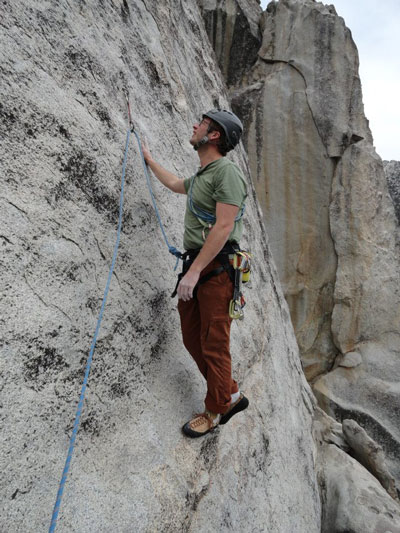
Photo courtesy Ryan Strickland
Tahquitz occupies a distinguished place in rock-climbing history. The rock-climbing portion of the Yosemite Decimal System of grading climbing routes was developed on Tahquitz in the 1950s. The grading system spread to Canada and the rest of the Americas.
Ryan Strickland, physics and math teacher at Idyllwild Arts, learned to climb on Tahquitz after arriving in Idyllwild in 2009. By learning to climb on a rock famous in climbing lore, he also embraced clean climbing — a pure, equipment-light climbing style pioneered on Tahquitz by Royal Robbins, Yvon Chouinard, Tom Frost and others as part of the late 1950s and early 1960s climbing movement in Idyllwild.
As the popularity of climbing mushroomed, companies began producing climbing equipment that made ascents of even the most difficult routes easier and made the sport accessible to the masses. But popularity came at a cost. As more people took up the sport, using more and more equipment to do so, climbing areas and rock surfaces began to suffer from increased pounding of equipment into rock faces.
Strickland will talk about the clean-climbing style that still survives on Tahquitz when he inaugurates the Idyllwild Nature Center’s speaker series. Robbins and the early Tahquitz climbers believed in climbing light, erasing the route as it was climbed rather than leaving a piton- and bolt-heavy record on the rock. Robbins espoused clean climbing as part of a moral responsibility to maintain the physical integrity of the mountains.
Chouinard, who later founded Patagonia, a company that made climbing hardware, wrote of the opposite polarities of “clean” and “aided” climbing. “The 1960s marked an awakening in American climbing characterized by a vast increase in climbing activity closely paralleled by a corresponding improvement in technique and equipment,” he noted in “A Word,” published in Patagonia’s catalog in October 1974. “Significant climbing advances have resulted. On the other hand, this combination is producing a serious problem — deterioration of the climbing environment. The deterioration is two-fold, involving the physical aspect of the mountains and the moral integrity of the climbers.”
This is the substance of Strickland’s talk and equipment demonstration. “Excessive protection takes away the adventure,” said Strickland. “Success is guaranteed at some point [through use of equipment] with no self-restraint. Some of the world’s best modern climbers do a lot of ‘bolt-down’ climbing. It gives them the safety net to try the most dangerous things. Without the bolting it would not be physically possible.”
Strickland said the best climbers are capable of climbing in a more clean way but that novice climbers, climbers of his generation, have learned differently from the clean-climbing pioneers like Robbins. “Many of my generation learned on a gym climbing wall and [when they rock climb] they expect that same level of support,” he explained.
In six years of climbing, Strickland has grown significantly as a climber, using a clean-climbing approach. “I’ve climbed 94 different routes on Tahquitz and Suicide,” he recounted. “I have climbed in Idyllwild every month of the year and have climbed Tahquitz over 100 times at least.” He’s also climbed El Capitan, the West Face of Yosemite’s Leaning Tower and three big walls in Zion — Moonlight Buttress, Space Shot and Touchstone Wall.
Strickland is modest about his climbs. “There are probably more than a million people alone in California who are more skilled than I am,” he said. “My strength is persistence.” Though modest about his skills, he is an ardent advocate for traditional, clean climbing. “The modern bolt-down style of sport climbing was not done here. Tahquitz remains clean. Anyone who climbs in Idyllwild is aware of the style of climbing up here, and they respect the history and the beauty we have here.”
In addition to discussing the history of climbing in Idyllwild, Strickland also will review the basics of “lead” climbing and display equipment he uses. “There will also be a slideshow of [rock climbing] images, both historic and current that will play during the lecture,” he said.
Strickland’s presentation is at 6:30 p.m. Friday, Feb. 19, at the Nature Center on Highway 243. Admission is $4 for adults, $3 for children and free to Friends of the San Jacinto Mountain County Parks members.











“bolt down” is usually called “rap-bolting” (drilling holes and placing bolts into the rock while rappelling from the top)…common at most sport climbing areas and accepted by most climbers in those places…Yes, Tahquitz used to see a lot of piton climbing, and still does occasionally. What Chouinard and Robbins were talking about was the use of pitons, hammering nails into cracks causing damage. Rap-bolting is a newer issue (since the 80s) and really doesn’t hurt the rock any more than any other bolting….note that the picture there of Strickland shows him using a bolt on the face…that was placed by drilling into the rock…but probably not on rappel so it is considered traditional. It’s a bit complex, the whole thing, but bolts are bolts and there are bolts on Suicide and Tahquitz that were not placed from stances, it is that simple, and he is using bolts of an unknown origin. Rap-bolting is not that big of a deal, all things considered.